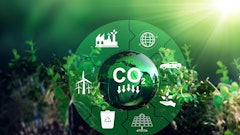
The words technology and sustainability might not seem synonymous but today, they've become a focal point in supply chain operations. As global supply chains grow in complexity and scale, companies are seeking more and more ways to balance economic efficiency with environmental responsibility. As we've continued to see in other sectors, new technology is skyrocketing as a key enabler in achieving this balance, driving significant improvements in sustainability while optimizing operations and assisting to overcome a unique set of challenges.
Challenges of All Shapes and Sizes
Challenge in implementing sustainable practice is ongoing and everchanging, regardless of what level or section of supply chain operations. This can hinder the starting line. As Pete Rau, VP of enablement & solution consulting at EcoVadis, explains, while more CEOs are enhancing visibility on sustainability impacts in their value chain (33% of companies now incentivize ESG outcomes for their supply chain), a significant number of companies are still in the early stages of integrating sustainability visibility and indicators into their procurement processes, for example, and other business functions.
Many of the primary obstacles slowing the adoption of sustainable procurement best practices today, according EcoVadis research, include:
- Lack of ongoing C-suite engagement and buy-in: Less than 50% of mainstream programs use integrated ESG data to “operationally inform” or “strategically engage” their executive stakeholders.
- Low ESG integration into the procurement tech stack: Although 50-60% integrate ESG data manually or digitally into procurement processes, only 30% of those integrations are reported as “very” or “extremely” effective.
- Limited value chain visibility and engagement: Only 50% of companies have visibility into more than half of tier 1 suppliers, and just a quarter have 50%+ visibility into tier 2.
- Lack of supplier engagement: Fewer than 50% of mainstream sustainable procurement programs engage suppliers with assessments or audits, and even fewer engage in follow-on activities including corrective or improvement action plans, GHG/carbon emissions reduction programs, or e-learning and training.
Budget Restraints
One key challenge that companies face is budget; according to Katrina Duck, enterprise account executive at Inspectorio, it's difficult to assign a budget to the initiative and to measure the return on investment.
"That said, government regulations play the biggest role in – and have the heaviest influence on – sustainability. In response to growing regulations and requirements, companies are increasing their compliance budgets to meet sustainability mandates; in a recent report from Inspectorio, 93% of supply chain professionals said that compliance budgets have remained the same or increased. Companies cannot afford to defund anything in the sustainability space because they’d risk the consequences of noncompliance," says Duck.
A highlighted example from Duck is Canada’s new Greenwashing Law, where companies are no longer allowed to make environmental claims without solid data or certifications – at the risk of steep financial penalties. The bill’s requirements are ambiguous, Duck explains, so some companies are removing green marketing claims altogether, even if they’re not inherently false, to avoid penalties. It also gives the companies that have the robust documentation to support sustainability initiatives an advantage.
Similarly, Tom Moore, founder and CEO at ProvisionAI, says a key concern in transportation is the desire to hit home runs: going to zero carbon rather than incremental improvements that can be implemented quickly without impacting profits.
"The problem with going to zero is the expense. For the most part, using lower carbon-intensive transportation for Class 8 (Semi Trucks) is more expensive and lacks the infrastructure to support it," says Moore. "Electric trucks are costly and require significant payload reductions because of the batteries' weight. They also require downtime to charge and, of course, the charging infrastructure. Hydrogen power, with zero emissions, is much more expensive when “Green” hydrogen is used. (Most hydrogen is produced from natural gas—which is not considered Green). The same cost and infrastructure issue apply to reduced-carbon-intensity solutions like compressed natural gas (CNG) or liquid petroleum gas (LPG)-powered vehicles."
Measuring and Reporting
It's one thing to say something and another to prove it factual. When it comes to reporting the impact of sustainable change, it's both of upmost importance to track and extremely difficult to measure. "A fundamental problem is measurement. Companies are very good at measuring how much water they use, how much raw materials they consume, what they throw away, and even understanding how much CO2 is admitted from their operations. But how do you measure Scope 2 and Scope 3 emissions? Scope 2 emissions are from utilities, such as the share of CO2 generated from the electricity used. Scope 3 emissions are generated by carriers moving materials to and from plants and warehouses," says Moore. "Do you include deadhead miles? If so, just pick up or just delivery? How do you know what the deadhead miles are? How do you know the fuel consumption of the equipment they’re using? The list goes on. Is a CNG-powered truck that has to deadhead 100 miles to pick up a load better than a diesel truck with a much smaller deadhead? How can you control something that is hard to measure?"
These are questions to ask in the planning phase of integration and considerations to bring to the table in the search for data and technology that works to improve visibility. Sustainability in supply chain is as complex as they come, with Duck expressing the near impossibility of managing the amount of complexity that’s involved without technology that can centralize all the factors.
"AI is an essential part of this, and it plays a huge role in helping companies adopt sustainable practices. For example, AI can automate tasks that are manually difficult, can quickly validate documents, share optimized resource allocation recommendations and more. AI drives efficiently, transparency and sustainability for companies." says Duck.
Regulations and Policies in the Driver's Seat
You'd be right to consider that regulatory bodies were once at the helm of the sustainable movement but what about today? Sustainability has morphed into a consideration that companies, and individuals for that matter, craft their own responsibility around. So far, Moore says, the government has left it to companies to determine how much they want to invest in a low-carbon future. "According to McKinsey, only 7% of shippers are prepared to pay more for carbon-efficient transportation. Only 15% will consider carbon in the decision. Put another way, 85% are more focused on cost than carbon. A government-forced move to “Green” will inflate consumers’ costs. At this time, they are unlikely to do that," says Moore. However, in procurement Rau explains that the notion that sustainable initiatives might be fading is far from reality.
"We're witnessing a significant expansion of ESG regulations globally, and this is compelling companies to rethink their compliance and risk management strategies. The emergence of global regulations like the EU’s Corporate Sustainability Due Diligence Directive (CSDDD) and the Corporate Sustainability Reporting Directive (CSRD) is placing new pressures on companies, requiring them to gather and report on high-quality ESG data, assess their double materiality, and develop robust sustainability strategies. In North America, laws like California’s Climate Corporate Data Accountability Act and Canada’s Modern Slavery Act (S-211) are also raising the bar, making it clear that sustainability is no longer optional," says Rau.
Companies are recognizing that sustainable practices help with more than just complying with regulations but are now part of good business fundamentals. Data from EcoVadis shows that “companies that achieve advanced level performance on ethics, environmental and labor practices within their supply chains” have higher profit margins than their peers with low sustainability performance— making it that more enticing from company leadership to place more emphasis on.
Best Practices in the Face of Consumerism
In transportation, Moore describes how existing technologies, such as route optimization, load consolidation and load optimization, are financially accretive and now contribute to a greener world. And this to a growing list of best practices and technology in your tool belt, along with adoption of some quality zero-carbon solutions.
On the topic of digitization, Duck says it's one of the biggest practices giving companies an advantage in sustainability through saving time and fueling efficiency. "Especially when it comes to sustainability, and the need to be compliant and manage at scale, the accuracy that comes from digitization is crucial. It is no longer a ‘plus’ to digitize the production chain, it is an imperative," says Duck.
AI, blockchain and IoT have all kinds of implementation options for businesses to utilize in their day-to-day operations, from transportation to manufacturing, that might support or improve sustainability. In procurement for example, Rau explains that, when trained with a large sample of human-validated data, AI and machine learning can help scale and reshape how companies manage their sustainable procurement programs.
"These tools can enable broader and faster visibility into ESG-related risks - as well as transparency - across their supply chain, especially when compared to homegrown surveys and self-declarations. For example, in addition to expanding reach, these technologies can offer continuous risk scanning and analysis, mitigation and improvement recommendations, and visibility to help organizations address the transparency requirements of various supply chain laws such as LkSG, French Duty of Care, the EU Directive on Due Diligence and more. Lastly, digitization of integration to procurement systems - for example via API - empowers buyers and category managers to seamlessly integrate those insights into the tools they use every day to make purchasing decisions," says Rau.
And what role might the consumer play? The consensus seems to be, mixed. Duck describes the impact of consumer demand to be less significant than a layperson might expect, with a recent report from Inspectorio revealing that only 14% of supply chain professionals view consumer behavior as a significant influence to supply chain strategies.
The younger demographic, with the future power of change to the market, may be the ones shifting that idea through support for sustainable brands, or at least those they deem to be more morally right in the environment or on humanity as a whole.
"It’s not just investors and legislators — consumers now expect corporate businesses to serve a social purpose and improve sustainability in their supply chains to drive real results. Consumers are no longer passive buyers; they are active stakeholders, demanding transparency, ethical practices and environmental responsibility from the brands they choose to support. This shift is fueled by growing awareness around environmental and social issues, with consumers increasingly holding companies accountable for the sustainability of their products and services - with many willing to pay more for sustainable products," says Rau.
The complexities of sustainability are not a one-size fits all quest. The challenges are as nuanced as the technology available to influence the improvements that meet the growing needs of companies, regulations and consumers. The future makes space for the potential of achieving better balance between economic growth and environmental stewardship in the supply chain, and who knows what the future holds.


















